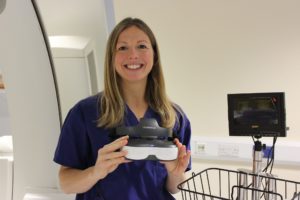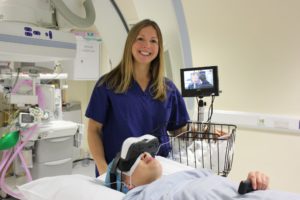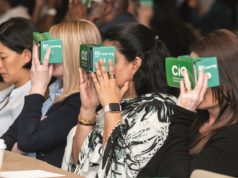
The Royal Bournemouth and Christchurch Hospitals NHS Foundation Trust, Bournemouth, UK, has become the first in the country to offer patients audio-visual goggles to distract and comfort them when undergoing an IR procedure without general anaesthesia or with only local anaesthetic. With a 100% patient satisfaction, the iTV FPView 3D HD goggles have been used in a variety of interventional radiology procedures where the patient lies supine for longer than 20 minutes, including prostate artery embolization, transarterial chemoembolization, superior rectal artery embolization, complex vascular recanalisation, and for GI bleeds. Here, project leader Clare Bent discusses the lessons learned from the patient experience, and how her Trust could serve as a model both nationally and internationally.
Audio-visual (AV) technology may be the next global initiative within interventional radiology (IR) to improve the patient experience during invasive medical care.
I have been leading the IR team at the Royal Bournemouth and Christchurch Hospitals (RBCH; Bournemouth, UK) in a quality improvement project to assess the benefits of AV goggles in the IR setting. These video goggles stream personal entertainment directly to the patient during IR procedures (HD and 3D videos, daytime television, box sets or real-time procedural imaging), aiming to distract and reduce anxiety and awareness. Published data suggests that AV distraction is a promising analgesic technique that is safe, reduces intravenous sedation and general anaesthetic requirements, and consequently allows for earlier ambulation and discharge following medical treatment.
Why were the goggles introduced?
With IR at the front-line of medical innovation, newer complex procedures frequently result in an increase in procedural duration. Further research into non-pharmacological methods to optimise patient experience and complement these technical advancements is warranted.
For longer procedures, a static position, lying on a relatively hard IR table, can be poorly tolerated by patients. With pain perception known to have a large psychological component, distraction techniques such as AV use a) allows time to pass expeditiously and b) deflects the patient’s attention from noxious stimuli with a consequential reduction in perceived pain.
Patient experience and pain measures—using visual analogue score (VAS), sedation requirements, length of postprocedural hospital stay, and a cost-benefit analysis—are examined. The RBCH IR team is hopeful that the AV goggles will benefit the patient and improve hospital throughput.
What was the patient experience like?
To date, 30 patients have trailed the AV goggles with 100% positive feedback.
Patients have commented that the focus of attention to streamed media has meant they have not noticed the invasive treatment being undertaken.
One patient undergoing resuscitation and embolization for a gastrointestinal bleed requested to watch Formula One during the procedure to distract him from the resuscitation team’s clinical management, and fed back positively that the distraction had improved his otherwise traumatic experience.

What are the key lessons from the quality improvement project?
- Not all patients want to be distracted during invasive procedures.
- A small proportion of patients experience simulator sickness.
- Infection control requires early involvement to ensure the device adheres to Trust guidance:
- Use of eye guards to prevent skin contamination
- Use of disposable earphones
- Ensure AV equipment chosen is robust enough to undergo thorough cleaning with Universal wipes between patients.
- Confirm with BBC [British Broadcasting Corporation] Licensing that your hospital trusts current TV Licence covers streaming and goggle use in this way. Notify the Trusts IT department to ensure WiFi capacity supports use of streaming.
- Consider a smaller monitor to video loop streamed media to enable the operating team to trouble shoot viewing issues to assist the patient.
- Consider which streaming tool to use—RBCH use a Now TV USB stick which has a remote control and also voice recognition to facilitate patient use.
- Counsel patients on the need for compliance with instructions and that excessive fidgeting from funny or scary imagery may require a change of channel!
How could this be rolled out nationally and internationally?
The quality improvement project will run initially for a six-month period to enable data collection. Following completion, the RBCH IR team aim to present and publish their findings to Trust management and to a wider audience within IR.
Internally, endoscopy, day theatres, and cardiac intervention have already requested a roll out of AV goggle use to facilitate improved patient experience in their own departments drawing on data and learning from this quality improvement project. Additionally, RBCH have received positive enquiries from national hospitals and industry, with the latter considering inclusion as part of IR suite specifications for future projects.
This quality improvement project hopes to recommend the use of AV goggles as a simple, non-invasive, low cost, and non-pharmacological method to improve patient experience and hospital throughput, which will in turn complement recent and future advances in IR.
Clare Bent is an interventional radiologist at the Royal Bournemouth and Christchurch Hospitals NHS Foundation Trust, Bournemouth, UK.













